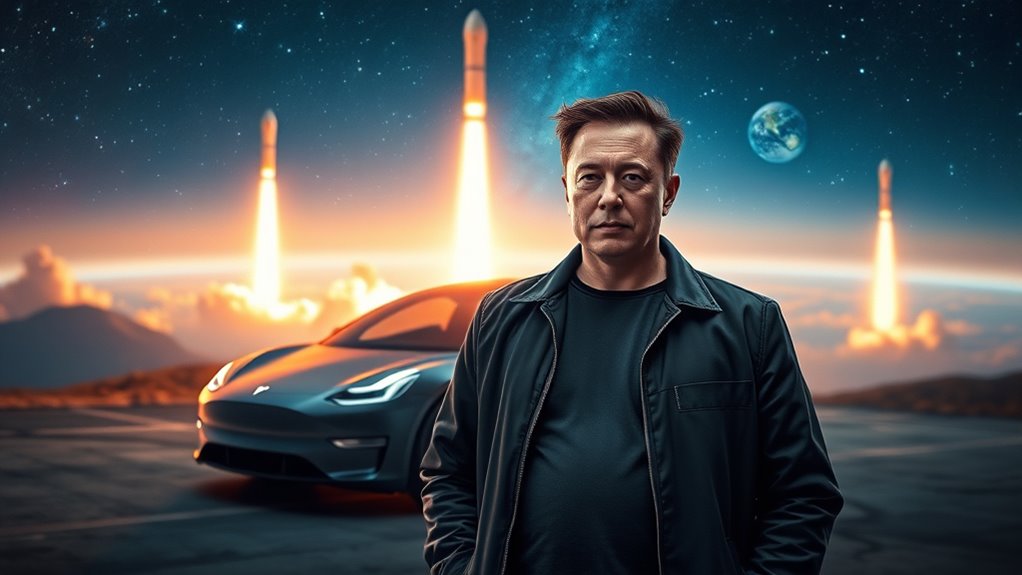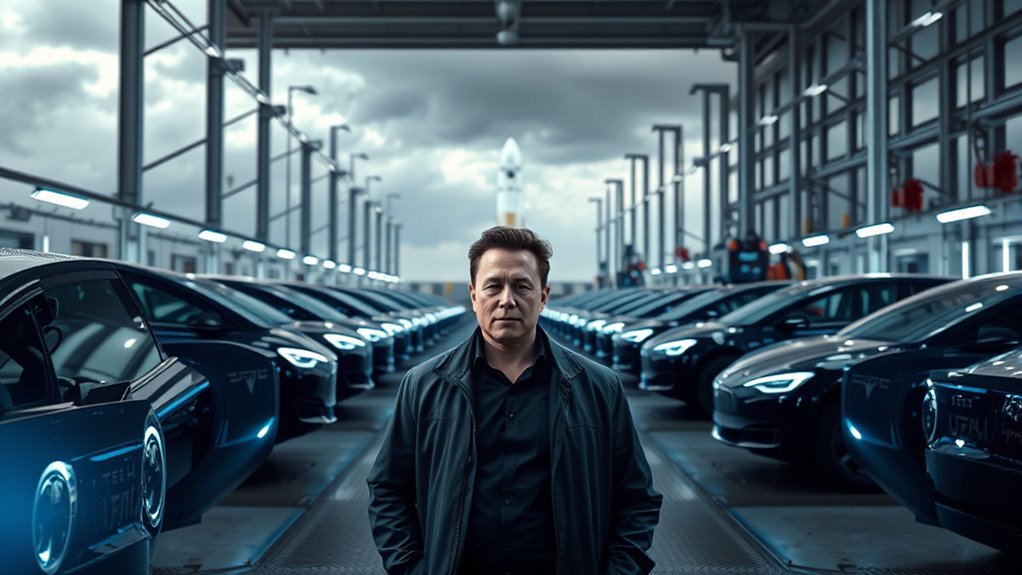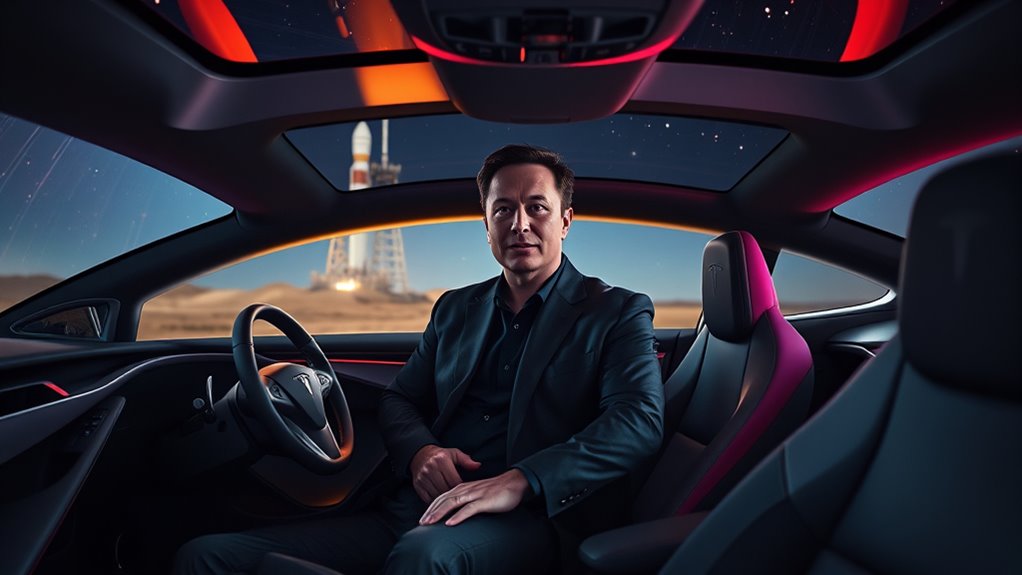Elon Musk is transforming transportation and space with innovative electric vehicles, solar energy, and reusable rockets. His company Tesla leads the shift to sustainable mobility, while SpaceX pioneers private spaceflight and plans for human missions to Mars. His vision includes cutting-edge tunneling projects and AI advancements that aim to reshape how we live, travel, and explore beyond Earth. If you keep exploring, you’ll discover more about how Musk’s ideas are shaping our future.
Key Takeaways
- Elon Musk leads Tesla, revolutionizing transportation with electric vehicles and innovations in battery tech and charging infrastructure.
- He founded SpaceX, pioneering reusable rockets and advancing human exploration with plans for Mars colonization.
- Musk develops cutting-edge transportation solutions like hyperloop tunnels and underground transit systems to reduce traffic and emissions.
- His innovations in energy storage, solar power, and sustainable development aim to transform global energy markets.
- Musk’s focus on AI and robotics aims to automate industries and enable human expansion beyond Earth.
Elon Musk’s Wealth and Financial Status

Elon Musk’s wealth is among the most extraordinary in the world, with an estimated net worth of around $381 billion as of May 2025. You might find it astonishing that his net worth peaked at $486 billion in December 2024 but dropped to about $330 billion by March 2025. According to Forbes, it’s roughly $424.7 billion. Musk became the first person to surpass $300 billion in 2021 and crossed the $400 billion mark in late 2024. Most of his wealth isn’t in cash but tied up in assets like Tesla and SpaceX stocks. For example, Tesla stock alone was valued at over $200 billion, and SpaceX held a valuation of $350 billion. Despite these assets, Musk describes himself as “cash poor,” highlighting how much of his wealth remains in assets like stocks. Market fluctuations continue to significantly impact the valuation of his assets, causing his net worth to vary widely over short periods. Additionally, the asset valuation can be highly volatile due to market conditions, which is a common characteristic of high-net-worth individuals whose wealth is primarily tied to investments. This volatility emphasizes the importance of understanding wealth management strategies among the ultra-wealthy. Fluctuations in asset values underscore the need for financial planning to maintain wealth stability over time.
Tesla: Revolutionizing Electric Transportation

Have you ever wondered how Tesla has transformed the way we think about transportation? Despite recent sales dips, Tesla remains a leader in electric vehicles, producing over 362,000 cars in Q1 2025 and delivering about 336,000 worldwide. This marks a 13% decrease from last year and a 32% decline from the previous quarter, yet Tesla’s innovation continues to set industry standards. Their advancements in battery tech, autonomous driving, and charging infrastructure push the industry forward. Additionally, their ongoing brand reputation is bolstered by consistent innovation and customer loyalty. Here’s a snapshot of Tesla’s recent performance:
| Metric | Q1 2025 Data | Change from Last Year | Change from Last Quarter |
|---|---|---|---|
| Vehicles Produced | 362,000 | — | — |
| Vehicles Delivered | 336,000 | -13% | -32% |
| US Sales | 128,100 | -8.6% | — |
| European EV Registrations | Surpassed Tesla in April | — | — |
Tesla’s ongoing innovation drives the electric revolution forward by expanding its product lineup and increasing production capacity. Furthermore, their battery technology advancements are enabling longer-lasting and more efficient energy storage solutions, which is crucial for the industry’s growth. Additionally, their focus on sustainable technology continues to inspire the industry to adopt cleaner energy solutions. Furthermore, improvements in GMC tuning techniques are helping traditional automakers enhance vehicle performance and efficiency, complementing the advancements pioneered by Tesla.
SpaceX: Pioneering Private Spaceflight

Since its founding in 2002, SpaceX has rapidly transformed the landscape of space exploration by developing revolutionary technologies and achieving milestones once considered impossible. You’ve seen their Falcon 1 become the first privately developed liquid-fueled rocket to reach Earth’s orbit in 2008. In 2012, their Dragon spacecraft became the first private craft to visit the International Space Station. By 2020, SpaceX made history as the first private company to send humans to space. You’ve also watched them pioneer reusable rocket technology, drastically lowering launch costs. Their fleet includes Falcon 9, Falcon Heavy, and the ambitious Starship, designed for Moon and Mars missions. SpaceX’s innovations, partnerships with NASA, and focus on cost-effective space travel have positioned it as a leader in private spaceflight, shaping the future of exploration beyond Earth. Reusability and landing capabilities have been central to their strategy, allowing for multiple launches with a single rocket, significantly reducing expenses. Their emphasis on cost reduction strategies has propelled them to the forefront of commercial space endeavors. Additionally, their use of advanced manufacturing techniques has further enhanced the efficiency and affordability of their rockets. Moreover, their ongoing efforts in technological innovation continue to push the boundaries of space exploration, including sustainable space practices that aim to minimize space debris and environmental impact. Furthermore, the integration of ProTextile supersede fabric technology in their suits and equipment highlights their commitment to innovative, sustainable materials.
Innovations in Transportation and Energy

You’re at the forefront of Elon Musk’s groundbreaking work in transportation and energy, where innovations like electric vehicles and solar tech are transforming daily life. Tesla’s advances in battery technology and charging infrastructure are making sustainable options more accessible than ever. These developments are reshaping how we think about mobility and energy use, paving the way for a cleaner future. Moreover, Musk’s extensive patent portfolio, which includes 28 patents across various industries, underscores the broad scope of his technological contributions and ongoing innovation efforts. Additionally, Kia Tuning showcases how vehicle modifications can further enhance performance and aesthetics, aligning with the broader theme of technological advancement and customization in transportation. The integration of Gold IRA options reflects a strategic approach to diversifying investments in innovative sectors. His focus on renewable energy solutions demonstrates a commitment to reducing reliance on fossil fuels and promoting sustainability, which is a key aspect of emerging technologies. Recognizing the importance of sustainable development, Musk’s initiatives emphasize long-term environmental benefits alongside technological progress.
Electric Vehicle Advancements
Are you curious about how innovations in transportation and energy are transforming electric vehicles? Today’s advancements are making EVs more accessible, practical, and safe. You’ll notice models like Tesla’s Model 2 expected to start at around $12,000, boosting affordability. Improvements in driving range mean you can travel farther without recharging. Manufacturing innovations ensure vehicles are safer and more reliable, with reduced structural inconsistencies. Tesla’s global expansion is increasing production capacity, meeting rising demand worldwide. The competitive market fuels rapid innovation, constantly pushing technology forward. EV sales increased to 8.7% of all new cars sold in 2024, demonstrating a strong shift toward electric mobility.
- Lower costs with new models like Tesla Model 2
- Longer driving ranges for everyday use
- Safer vehicles due to structural enhancements
- Increased global production and market share
Additionally, ongoing research in structural safety improvements is helping to make electric vehicles even more resilient and dependable.
Solar and Battery Tech
Innovations in solar and battery technology are revolutionizing how you generate, store, and use energy. Tesla’s Powerwall makes residential energy storage simple, combining solar inverters for efficient setup and offering scalable options to meet higher demands. It seamlessly integrates into your existing electrical system, making energy management easier and more attractive. For larger needs, Powerpack and Megapack provide solutions for commercial, industrial, and grid applications. Megapacks connect directly to high-voltage networks, reducing costs and boosting reliability, as seen in projects like Hornsdale. Tesla’s breakthrough in solar panels, priced at just $0.19 per watt by 2025, aims to make solar power more affordable worldwide. These innovations, combined with AI-powered systems, optimize performance, reduce reliance on fossil fuels, and promote energy independence for homes and businesses alike. Additionally, the integration of sound design techniques in monitoring and troubleshooting these energy systems can improve their efficiency and reliability. Powerwall offers customizable power modes that enhance energy efficiency and provide reliable backup during outages, highlighting the importance of energy storage in modern energy systems. Incorporating vertical storage solutions can further optimize space and enhance scalability for diverse energy needs.
Infrastructure Development
Advancements in solar and battery tech are transforming energy infrastructure, paving the way for smarter, more sustainable transportation systems. These innovations enable large-scale projects like high-speed tunnels and hyperloop systems, which are designed to reduce travel times and urban congestion. Tunneling technology, such as the “Proof Rock 4,” speeds up construction and cuts costs, making underground transit more feasible. The Dubai Loop project aims to shift transportation underground, lowering emissions and easing traffic. Additionally, partnerships with companies like Amtrak are integrating tunnel systems with existing rail networks. These developments focus on scalability, environmental sustainability, and efficiency, creating a future where transportation is faster, greener, and more accessible. Incorporating vegetable juices into daily routines can also support overall health and energy levels, further benefiting those involved in innovative infrastructure projects. Nutritional benefits from juices can enhance worker health and productivity, contributing to the success of such large-scale endeavors.
Space Exploration and the Future of Humanity

Have you ever wondered what it takes to make humanity a multiplanetary species? Elon Musk’s SpaceX is working toward that goal with the Starship program, a reusable spacecraft designed for missions to Mars. The plan is to launch uncrewed missions as early as 2026, with human landings possibly happening by 2029 or 2031. Musk envisions establishing a self-sustaining colony on Mars, aiming for one million residents, to ensure humanity’s survival if Earth becomes uninhabitable. Overcoming challenges like radiation exposure, long-distance communication, and surface hazards is critical. Musk’s innovations—like in-orbit refueling and resource utilization—are key to creating sustainable, autonomous settlements. This bold vision could redefine humanity’s future, turning science fiction into reality. Mars’ atmosphere, primarily CO2 with nitrogen and argon, enables plant growth, which is essential for supporting a permanent human presence.
Strategic Investments and Market Impact

Strategic investments in transportation are reshaping how we move and connect. Elon Musk’s ventures, like Tesla’s upcoming robotaxi services in Austin, aim to revolutionize urban mobility. Collaborations such as Uber’s with Pony.AI in Saudi Arabia highlight the push toward autonomous vehicles, which could cut labor costs and boost efficiency. These innovations also bring significant market impacts, including economic benefits from safer, smoother traffic flow and environmental gains from electric vehicles. However, competition is fierce, with Tesla facing rivals like Uber. Regulatory support, especially in places like Saudi Arabia, accelerates adoption, while ongoing technological advancements improve safety and reliability. These investments signal a shift toward smarter, cleaner, and more connected transportation systems that could transform daily life.
- Tesla’s robotaxi launch in Austin
- Uber’s autonomous vehicle partnership in Saudi Arabia
- Economic and environmental benefits of EVs and AVs
- The competitive landscape shaping transportation innovation
Challenges and Fluctuations in Musk’s Empire

You see how Musk’s empire faces constant ups and downs in the stock market, with rapid swings affecting asset values. These fluctuations often reflect broader uncertainties about Tesla’s performance and Musk’s bold promises. As a result, investor confidence can shift quickly, creating ongoing challenges for maintaining stability.
Stock Market Volatility
Stock market volatility has become a defining challenge for Elon Musk’s empire, driven by fluctuating investor sentiment, industry pressures, and high-profile product launches. You see, analysts are divided on Tesla’s future, with price targets ranging from $22 to $444 per share. While some, like Daniel Ives, remain optimistic about growth and autonomous robotaxis, skepticism about Tesla’s high valuation persists. The EV market’s rising competitiveness, potential production setbacks, and macroeconomic factors like interest rate hikes add to the uncertainty. Major product launches, especially the June 2025 robotaxi debut, can cause rapid stock swings. Trading activity spikes around such events, with Tesla’s stock fluctuating between $222 and $428. This constant flux reflects market fears, speculation, and the inherent risks of innovation and expansion.
Asset Value Fluctuations
Elon Musk’s empire experiences significant fluctuations in asset values, reflecting both rapid growth and unpredictable risks. Tesla’s Bitcoin holdings, valued at around $1.2 billion, highlight recent gains, while Tesla’s stock has surged over 25%, adding approximately $225 billion in market value. Musk’s combined company valuations have increased by $613 billion since the last election, with SpaceX valued over $250 billion and xAI raising up to $6 billion at a $50 billion valuation. Despite these gains, Musk faces challenges like regulatory scrutiny over Tesla’s $55 billion pay package and environmental concerns linked to Bitcoin mining. The X platform has also seen a 79% decline in value. Financial Impact of Musk’s Companies Since Election These fluctuations demonstrate the volatile nature of Musk’s investments, requiring strategic risk management amid ongoing market and regulatory uncertainties.
Musk’s Broader Vision for the Future

Musk’s broader vision for the future envisions a world transformed by advanced AI, robotics, and sustainable energy solutions that fundamentally reshape society. You’ll see AI surpassing human performance in medicine, law, and education, automating nearly all cognitive tasks and sparking new ideas. As AI relies more on synthetic data, its growth accelerates, prompting debates on employment and human roles. Robotics, like Tesla’s Optimus, will become everyday household items, revolutionizing industries and routines. Tesla’s innovations in EVs, energy storage, and solar power will reshape transportation and energy markets globally. Meanwhile, Musk’s Mars colonization plans aim for a self-sustaining human presence within 25–50 years, pushing technological boundaries. Overall, his vision drives a future where technology addresses climate change, resource management, and human expansion. Additionally, the increasing frequency of extreme regional climate events underscores the urgency of developing sustainable technological solutions.
Frequently Asked Questions
How Does Elon Musk Plan to Fund Colonizing Mars?
You might wonder how Musk plans to fund Mars colonization. He relies on SpaceX’s core business, like launching Starship, which aims to cut costs and generate revenue. Additionally, he leverages profits from Starlink, his satellite internet service, and collaborates with governments for funding. Musk also envisions resource self-sufficiency on Mars, reducing reliance on Earth, and uses incremental missions to attract investments and partnerships, making the entire project financially viable.
What Are Musk’S Plans for Affordable Electric Vehicles?
You’re interested in Musk’s plans for affordable EVs. He aims to make electric vehicles accessible by designing a compact, lower-cost model (Model 2) priced around $11,179 to $12,000. Production will start in mid-2025 at Gigafactories in Texas, Mexico, and Shanghai, with the goal of reaching middle-class and fixed-income buyers. This strategy seeks to expand EV adoption and reshape the auto market through mass affordability.
How Does Musk Manage His Fluctuating Net Worth?
When it comes to managing his fluctuating net worth, you need to realize Musk keeps his eyes on the prize, reinvesting profits into his ventures rather than cashing out. He’s comfortable riding the waves of market volatility, understanding that his wealth is tied to long-term innovation. By focusing on strategic investments in Tesla and SpaceX, Musk balances risk and growth, even when the financial waters get rough.
What’S the Future of Tesla’S Autonomous Driving Technology?
You can expect Tesla’s autonomous driving tech to keep evolving rapidly. By 2025, full self-driving features will be more widespread, with improved neural networks and hardware like Tesla’s custom chips. You’ll see fewer human interventions, expanded global availability, and potential robotaxi services. Tesla’s focus on camera-based systems and real-time AI decision-making aims to make your driving safer, smarter, and more autonomous, shaping the future of transportation.
How Does Spacex Aim to Revolutionize Global Internet Access?
Imagine a world where your internet is as reliable as your morning coffee. SpaceX aims to make that happen with Starlink, using thousands of low Earth orbit satellites to deliver high-speed, low-latency internet worldwide. You’ll get seamless connectivity in remote areas, travelers will stay connected on the go, and businesses will benefit from robust communication. This satellite network is like building a digital bridge across the world’s most isolated places.
Conclusion
You see, Elon Musk’s journey shows that Rome wasn’t built in a day. His bold innovations are reshaping transportation and space, proving that with vision and perseverance, you can turn dreams into reality. As the saying goes, “The sky’s the limit,” and Musk’s work reminds you that pushing boundaries can lead to extraordinary breakthroughs. Keep dreaming big—you never know how far you might go when you reach for the stars.









